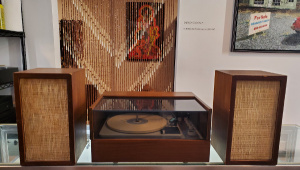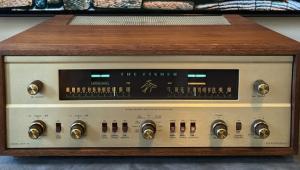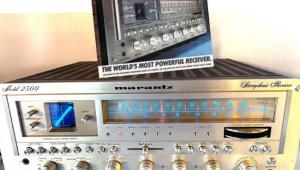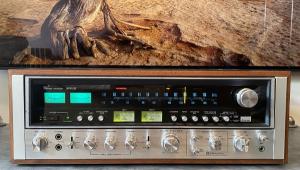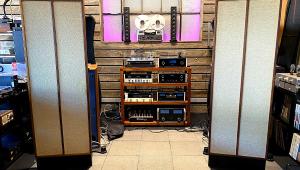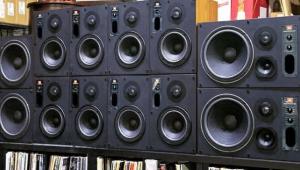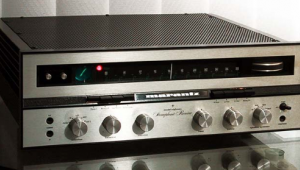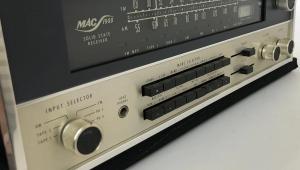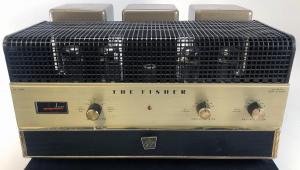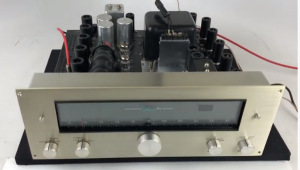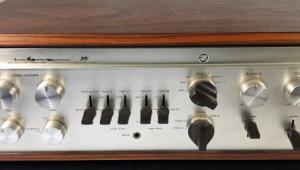The 800-B Receiver: An Avery Fisher Masterpiece Page 2
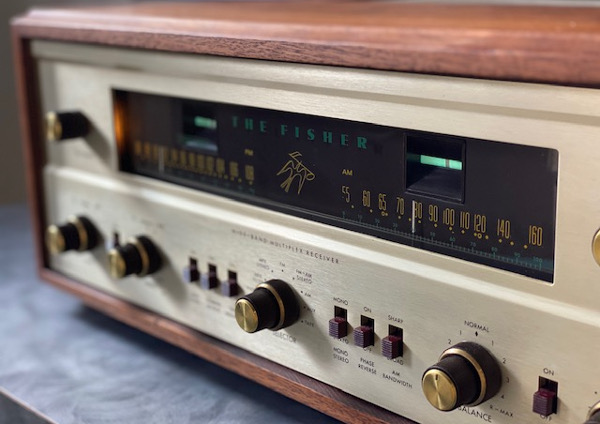
Needle in a Haystack
When Ben Hase posted an ad on Facebook seeking non-working stereo equipment on a recent family visit in Wisconsin, he was intrigued when he heard from a man who claimed to own a Fisher 800-B in very good original condition. “I drove to meet the seller on a very cold day and inspected the unit on a table outside,” recalled Hase, a hi-fi restoration specialist and owner of Novalux Stereophonic. “My hands were freezing but I managed to work a screwdriver to take off the bottom cover to confirm that there were no signs of catastrophic failure or transformer damage. Eventually, we settled on a price and I agreed to trade repair labor for some of the other items he had available. The 800-B came back with me to NYC for a full restoration.”
In the exchange that follows, Hase, who also works as a service/restoration technician for New Jersey-based SkyFi Audio — a joint venture with New York City’s Stereo Exchange that deals in vintage and esoteric audio gear — talks about finding and restoring one of the most sought-after pieces of audio gear from the early 1960s.
S&V: So, what’s the story behind the Fisher 800-B stereo receiver you recently acquired?
Hase: The gentlemen who sold me the unit stumbled upon it by chance one day at a Goodwill store in central Wisconsin. It was originally fitted into what was described as a home-built console with a Garrard turntable and a mix of GE, Fisher, and RCA drivers. The console was extremely heavy and hard to transport but it was an all or nothing deal so the owner had to enlist a friend to help him transport the fully loaded console home. They almost broke their backs getting it down a flight of stairs. When he got the unit home, he removed all of the components so they could be safely stored.
Over the years, the owner sold the drivers and turntable but hung onto the 800-B in hopes of someday having it restored. He believes the unit was originally purchased from a local TV sales and repair shop called "House of TV Service Company," which had a Fisher showroom — the only one of its kind in the area.
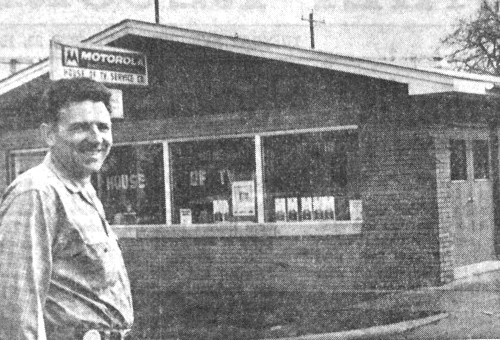
S&V: Great backstory. What do you find appealing about the 800-B?
Hase: I had never worked on a Fisher receiver before and wanted to see what all of the hype was about. The unit is all original, untouched, in good cosmetic condition, and it’s an all-tube design with tube-based AM, FM, preamp, and power-amp sections. It was a best-case candidate for restoration as no other technician had been inside of it performing break/fix repairs. Of course, it also has those beautiful “magic eyes.”
S&V: Tell us about the restoration.
Hase: When I first opened the unit to perform initial testing, I found that one pair of output tubes was compromised. I powered the unit up with only one set of outputs installed and was able to verify basic function one channel at a time. The unit fundamentally worked but the FM tuner was out of alignment and the electrolytic capacitors were nearing the end of their lifespan. After confirming that the power and output transformers were not damaged, I was able to proceed with the restoration.
There is a huge following associated with 1960s Fisher receivers. Over the years, many technicians more experienced than me have come up with creative ways to address some of the shortcomings of the original design, making use of modern components that either did not exist at the time or were far too expensive to be practical in consumer products. I considered a number of possible modifications but ultimately opted for a minimally invasive restoration with the goal of preserving as much of the Fisher magic as possible, while making the unit safe to operate and easy to re-tube.
I began with a full power supply rebuild, making use of custom-made multi-section can capacitors and NOS (new old stock) Allen-Bradley carbon composition resistors. I also rebuilt the negative bias supply, replacing the troublesome Selenium bridge rectifier with a modern Silicon equivalent. On the tube front, NOS balanced Telefunken 12AX7s are expensive but still fairly easy to source. Matched sets of NOS 7591 output tubes, however, are becoming scarce so I decided to install a new board that allows individual bias adjustments — the original design sends the same fixed negative bias voltage to all four output tubes necessitating the use of a matched set of four tubes for optimal performance. I also added screen resistors to the output tube sockets to allow for the use of both vintage and current production 7591s.
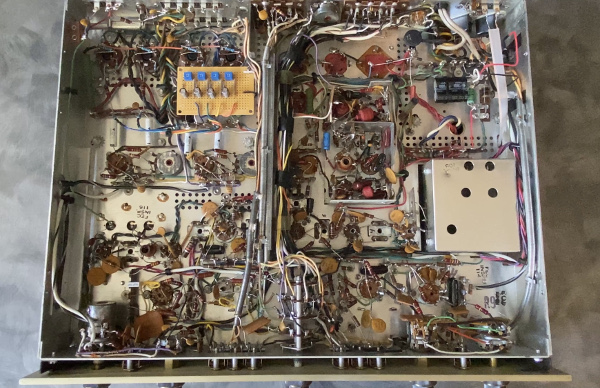
After testing all of the tubes, I relocated the best testing Telefunken 12AX7s to the sensitive phase inverter positions and installed a mix of NOS and current production 12AX7s in the line and phono stages. All remaining electrolytic capacitors were replaced and an alignment was performed on the AM and FM tuners. When the electronic restoration and alignment was done, the unit tested wonderfully on the bench, producing approximately 25 watts per channel into 8 ohms with surprisingly good frequency response.
Once the unit was electronically stable, it was time to move onto the cosmetic part of the restoration. This unit was pulled from a console so it had no cabinet. Luckily, I had a rough Fisher 400 cabinet in storage and it was a perfect fit for the 800-B. I sanded down the cabinet, addressed any significant blemishes, and refinished it in Danish oil. I also installed reproduction brass caps on all of the knobs as a finishing touch.
S&V: A pretty extensive restoration… How did you deal with the original (and now obsolete) FM-AM tuner?
Hase: Even though FM-AM stereo broadcasting never caught on, the independent FM and AM tuners along with the MPX module make the 800-B a fantastic receiver for listening to modern FM MPX and AM broadcasts. Fisher smartly designed this product to succeed in both cases. The only orphaned feature is the "FM-AM Stereo" selection on the source knob. The 800-B actually offers more features than a typical AM/FM Receiver with a shared AM/FM dial. AM and FM can be tuned completely independently, allowing the listener to effectively set an "AM preset" that does not change when FM tuning is adjusted.
S&V: Now that it has been fully restored, how does this audio classic perform?
Hase: My main takeaway is I find it uniquely satisfying to listen to a unit that is all tube from source to speaker. The only silicon parts are the diodes in the power supply and FM MPX circuits. Listening to FM was thoroughly enjoyable, and both the AM and FM tuners perform surprisingly well for 1960s tech. I would leave the FM playing all day during my long-term testing. (I like to test all my restorations for a minimum of three, 10-hour-straight sessions.) During this time, I am usually working on other projects. When the 800-B was running in the background, I found myself frequently sitting down to listen and, before I knew it, two or three songs had played. It's rare that listening to the radio draws me in like that. It’s also a pleasure listening to vinyl and other line-level sources to — the sound is warm and inviting just as you’d expect from a vintage tube amplifier.
The restored Fisher 800-B is listed for $2,799 on skyfiaudio.com. For a detailed video overview of Hase’s restoration, click here.
Related:
Classic Fisher Tube Amp Makes Rare Appearance, posted April 9, 2020
Visit Vintage Gear on SoundandVision.com for a repository of stories about classic audio gear.
